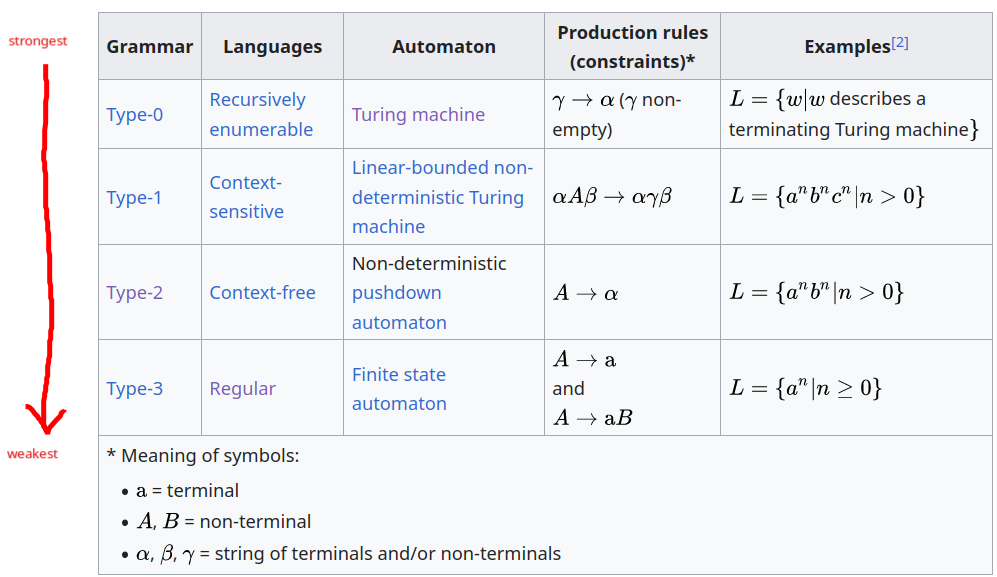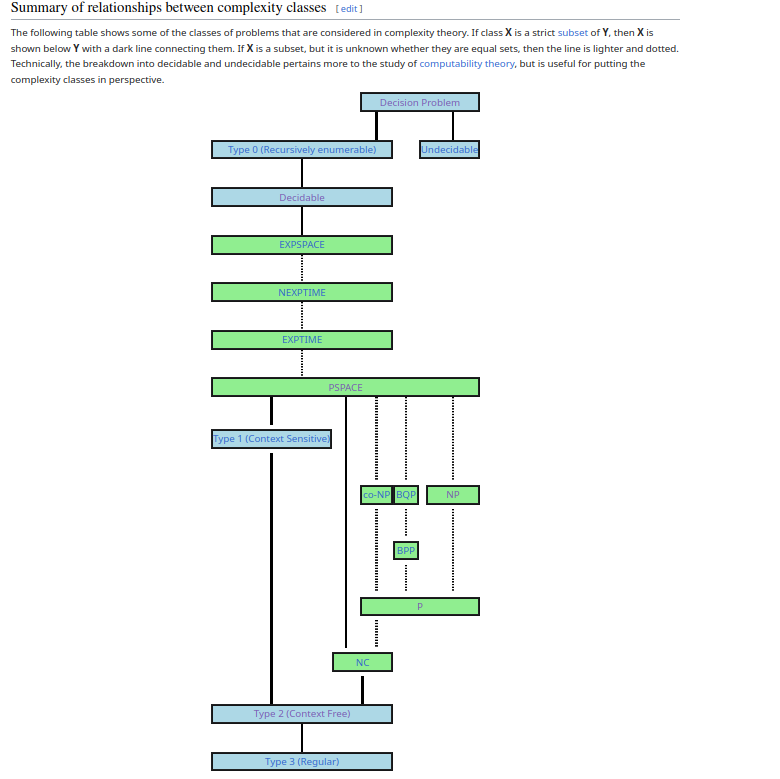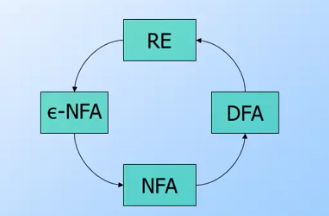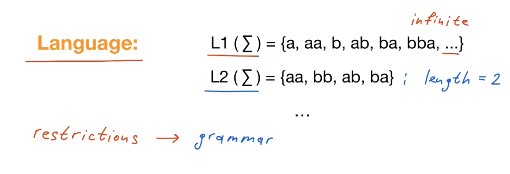tags : Regular Expressions, Automata Theory
The Chomsky hierarchy is descriptive. It simply allows us to broadly categorize grammars based on their capabilities.
The Hierarchy of Grammars (Generative Grammars)
- The hierarchy allows us to broadly classify grammars based on their productive power.
- They have increasingly strict production rules and can therefore express fewer formal languages.
- Type 2 and Type 3 are popular


Type 0 (Recursively Enumerable)
- AKA Unrestricted grammar
Type 1 (Context Sensitive)
- all context-free languages are also context-sensitive languages, but some languages are neither context-sensitive nor context-free.
- context-sensitivity is often not resolved in the parsing phase but in later phases
- Writing context-sensitive grammars is very difficult for people to do without spending a lot of time and effort on it. The CFGs, though technically inaccurate, often give us enough to work with that they can be useful.
- Most languages are actually context sensitive
Type 2 (Context Free)
- Used to parse programming languages
- The classic example people is
x * y;in C, which is either multiplication or a variable declaration, depending on whether x is a type or a value. This proves that C cannot be a context-free language. i.e there exists context that’s not encoded in the text already.- Solution to this is Lexer hack , giving access to some kind of symbol table to the lexer
- CFGs are not nearly powerful enough to describe natural language because natural languages are ungainly and complex.
X-bar theoryis essentially the application of CFGs to language modeling
Type 3 (Regular Languages)
- It’s not ideal to parse programming languages(Type 2) with regular expression hence.
- Things that Regular Expressions can parse (?)
Languages classes
- Set of languages. Eg. The regular languages
Properties
Decision Properties
- Eg. Empty, Finite, Infinite?, Does the protocol terminate, Does the protocol fail?
- Harder to answer for larger classes of languages
Closure Properties
- Given languages in the class, an operation (e.g., union) produces another language in the same class.
Regular Languages
- A
languagethat is accepted by a Finite Automata - Proofs for decision properties for regular languages require RE or DFA.


Descriptors
- Regular Expressions
- FA/FSM/DFA/NDFA/NFA (See Finite Automata)
Context Free Languages
- Let us do things that regular languages can’t do. Eg. Lets us process natural and programming languages, Match parenthesis or XML tags etc.
- Powerful than Regular Expressions and Finite Automata but still cannot define all possible languages.
Descriptors
-
Context-free grammars
See Context Free Grammar (CFG)
- Recursive system for generating strings
-
Pushdown Automata
- Generalization of Finite Automata(FA)
Recursively Enumerable Languages
- Turning machines : It can tell us what can be computed by computation and what cannot be.
Grammars to Alphabet
Although there are an infinite number of different things that can be said, or written down in a particular language, it is still possible to process and understand all of them with a finite number of re-write rules. The name given to a set of re-write rules is a grammar
Grammarsare defined byLanguagesLanguagesare defined by set ofStringsStringsare defined by sequence ofSymbols- Set of
Symbolsis defined by theAlphabet
Grammar
- Whenever we put restriction on a language, we create a grammar

Language
- A set of strings accepted by an automaton
Ais the language forA - Eg. If
Aacceptss-oands-o-o, then set of these 2 strings represent the language forA - Denoted by
L(A) - Different types of Automatons accept different languages
- They can be finite or infinite sets
- Personal Note:
L(Alphabet),L(Automaton)seem like the same thing.
String
- Eg. In C,
"O"isstring, while'0'is a character/symbol.
Alphabet
- Finite set of symbols
- Eg. ASCII, Unicode,
{0,1},{a,b,c}, set of signals used by some communication protocol